Creating Easy Homemade Bath Bombs: A Comprehensive Guide
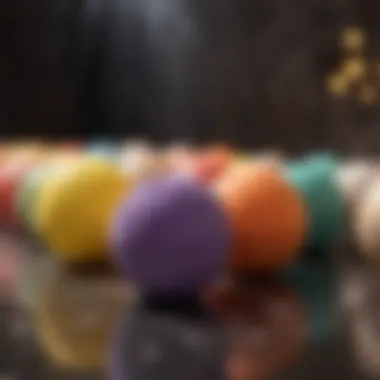
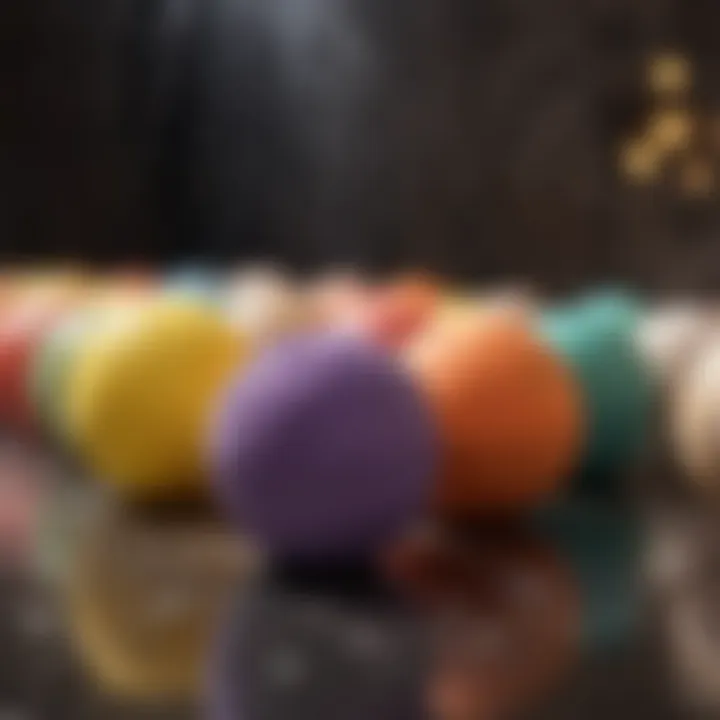
Well-Being Overview
Preface to the topic
Crafting homemade bath bombs may seem simple, yet it intertwines with aspects of well-being and self-care. Bath bombs provide not only a fizzy experience in the tub but also serve as a tool for relaxation and skin enhancement. Understanding this art can deepen one's appreciation for self-care routines and the impact they have on overall well-being.
Importance of focusing on this aspect of well-being
Creating bath bombs is a unique blend of creativity and mindfulness. During the process, one engages with various ingredients that can boost mood and sensory experiences. Incorporating essential oils can provide aromatherapy benefits, making bath time an opportunity for relaxation. With the right knowledge, bath bombs can cater to personal needs, enhancing both mental and physical relaxation.
Exploring the Ingredients
Essential Ingredients for Bath Bombs
When creating bath bombs, the right combination of ingredients is crucial for a successful product.
- Baking Soda: A primary ingredient, it reacts with citric acid, creating the fizz.
- Citric Acid: Provides the effervescent quality when combined with baking soda.
- Epsom Salt: Known for its therapeutic properties, it helps in muscle relaxation.
- Essential Oils: Options like lavender or eucalyptus offer aromatherapy benefits.
- Colorants: Natural colorants can be used to enhance the visual appeal.
These ingredients not only ensure the bath bomb's functionality but also its personal appeal.
Techniques for Crafting Bath Bombs
Step-by-Step Process
- Preparation: Gather all necessary materials and tools. Ensure workspace is clean and organized.
- Mixing Dry Ingredients: In a mixing bowl, combine the baking soda, citric acid, and Epsom salt. Whisk until all ingredients are uniform.
- Addition of Oils: Slowly mix in essential oils. It is important to add these gradually to avoid activating the fizzing reaction too soon.
- Coloring the Mixture: If desired, incorporate colorants. Adjust the quantity based on the desired intensity.
- Molding: Pack the mixture tightly into molds. Press firmly to ensure the bath bomb holds its shape.
- Drying Period: Allow the bombs to dry for at least 24 hours. This will ensure they are solid and can be stored easily.
Tips for Success
- Avoid using too much water when mixing; moisture can cause premature fizzing.
- Experiment with different molds to create unique shapes and sizes.
Personalizing Your Bath Bombs
Variations in Scents and Colors
Customization options are vast. Using different essential oils allows for various scent profiles. For instance, citrus oils can energize while floral scents provide tranquility. Color variations can reflect personal taste or even festive themes, making each bath bomb unique.
Troubleshooting Common Issues
While crafting bath bombs, one might encounter issues. If the bombs do not hold their shape, consider re-evaluating the moisture level. If they fizz too much after mixing, it is likely due to excess liquid.
"The art of making bath bombs can be a rewarding experience that enhances your self-care rituals."
The End
Homemade bath bombs stand at the intersection of creativity and relaxation. Understanding the ingredients and techniques enriches the experience of creating these delightful products. With knowledge in hand, each bath bomb can become more than just a bath accessory; it can transform into an integral part of a wellness routine.
Preface to Bath Bombs
Understanding bath bombs is essential for anyone interested in enhancing their self-care routine. This section outlines what bath bombs are, their purpose, and their historical significance. The importance of this topic lies in its broad appeal; bath bombs are not just a novelty but a medium for relaxation and enjoyment. They can be tailored to meet individual preferences in terms of scents and colors while also providing benefits like skin hydration and muscle relaxation.
Definition and Purpose
Bath bombs are effervescent spheres or shapes that dissolve in water, typically containing a combination of acids and bases. When dropped into a warm bath, they fizz and release various elements like fragrances, essential oils, and sometimes even colors. The primary purpose of bath bombs is to enhance the bathing experience, turning it into an event of relaxation and indulgence.
They often contain baking soda, which helps soften water, and citric acid, which creates the fizzing reaction. Essential oils may be included for aromatherapy benefits, targeting stress relief or energy-boosting properties. This transformation from a simple bath to a therapeutic soak is key for many users, resulting in improved relaxation and mood.
History of Bath Bombs
The origins of bath bombs can be traced back to the late 1980s when they were popularized by the brand Lush. Inspired by the concept of blending skincare with self-care, the founders believed that bathing could be more than a routine—turned into a sensory journey. Over time, bath bombs evolved not just in design and function, but also in the variety of ingredients used.
From traditional herbs and floral essences to modern synthetic fragrances, the possibilities grew immensely. Today, bath bombs are viewed as essential products for various wellness practices, including aromatherapy. They have cemented their place in the world of self-care and beauty. The continued popularity ushers in innovations, making them accessible to people with diverse preferences and skin types.
"Bath bombs not only change the way we bathe but also redefine self-care, offering an accessible luxury that many seek in their routines."
With this foundation on bath bombs, it becomes clear why learning to make them at home is beneficial. Not only does it allow for customization, but it also empowers individuals to take control over what goes into their bath products, ensuring they align with personal values and health considerations.
In the following sections, we will explore the essential ingredients, necessary equipment, and methods involved in creating effective homemade bath bombs.
Essential Ingredients for Homemade Bath Bombs
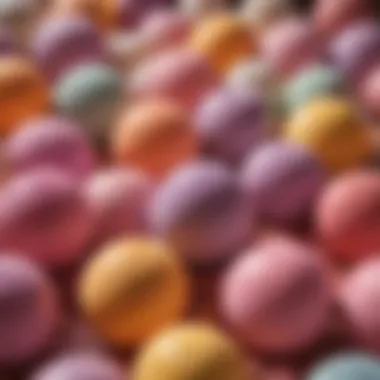
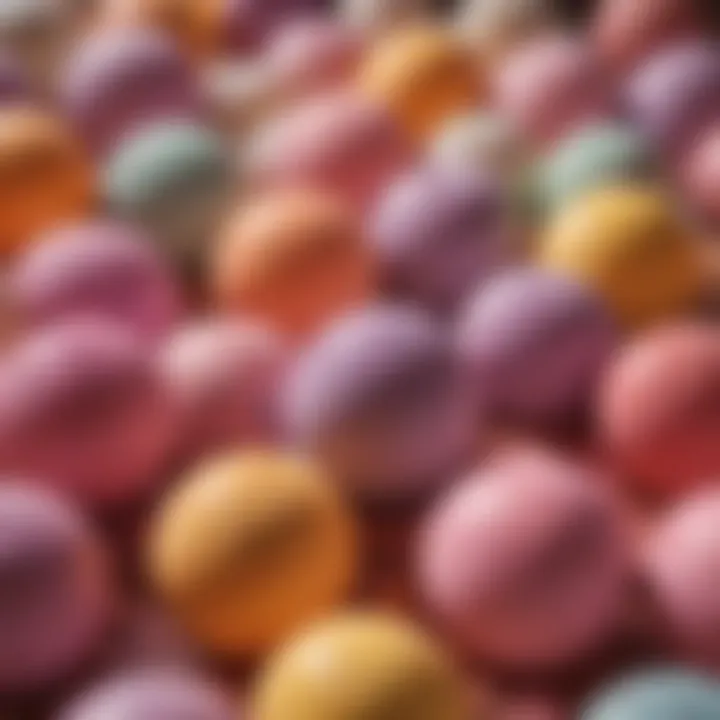
In the art of crafting homemade bath bombs, the selection of ingredients is paramount. Each component serves a specific purpose, ensuring that the final product is not only aesthetically pleasing but also functional. Understanding the essential ingredients helps to create bath bombs that provide relaxation, nourishment, and sensory enjoyment. The following sections will discuss each key element in detail, highlighting their benefits and the considerations one should take into account.
Baking Soda
Baking soda, also known as sodium bicarbonate, is one of the most vital ingredients in bath bombs. Its primary role is to create the characteristic fizz when the bath bomb comes into contact with water. This effervescence is not merely for show; it enhances the bathing experience by dispersing essential oils and other beneficial ingredients throughout the water. Moreover, baking soda is known for its skin-soothing properties. It can help to neutralize odors and soften the skin, making it a popular choice for those with sensitive skin.
Citric Acid
Citric acid is another crucial component. This natural compound, found in citrus fruits, reacts with baking soda to initiate the fizzing action. When combined with water, the chemical reaction produces carbon dioxide bubbles that create a sensory delight. Beyond its fizzy effects, citric acid is also a mild exfoliant, which can aid in removing dead skin cells during a bath. Furthermore, it is beneficial in balancing pH levels, which contributes to an overall improvement in skin health.
Epsom Salt
Epsom salt, or magnesium sulfate, is often included in bath bomb recipes for its therapeutic benefits. Magnesium is known for its ability to ease muscle tension and promote relaxation, making it a natural fit for a soothing bath. It can also reduce inflammation and draw out toxins from the body. In addition to its health benefits, Epsom salt enhances water softness, allowing for a smoother bathing experience. Its use can be particularly appealing for individuals who lead an active lifestyle.
Essential Oils
Essential oils are key for adding fragrance and therapeutic properties to bath bombs. These oils, extracted from plants, provide various benefits based on their unique properties. For example, lavender oil is renowned for its calming effects, while eucalyptus oil can be invigorating and refreshing. Selecting the right essential oils can tailor the bathing experience to individual preferences and needs. Importantly, attention must be paid to the quality of essential oils; high-quality, pure oils are most effective and safe for skin application.
Colorants
To elevate the visual appeal of bath bombs, colorants are often added. Options range from natural alternatives like beet juice or turmeric to synthetic dyes. While the choice of colorant may be driven by aesthetic preferences, it is essential to consider the safety and potential skin reactions. Natural colorants tend to offer a gentler experience and are preferable for those with sensitive skin. Moreover, vibrant colors can contribute greatly to the overall ambiance and enjoyment of a bath.
Understanding these essential ingredients paves the way for creating effective and enjoyable homemade bath bombs. Each ingredient contributes uniquely to the experience, ensuring that your bath time is both relaxing and rejuvenating.
Combining these elements with skill and care is crucial in achieving the desired bath bomb quality. Proper knowledge of the ingredients allows for the exploration of customization and experimentation, leading to uniquely crafted, personal bathing experiences.
Necessary Equipment and Tools
To create bath bombs successfully, having the right equipment and tools is essential. The process of making bath bombs involves measurements, mixing, and molding. Using the correct tools ensures accuracy and helps achieve the desired consistency and fizz. Below, the necessary equipment is detailed with explanations of their importance in this crafting journey.
Mixing Bowls
One of the primary tools you need is a set of mixing bowls. Mixing bowls allow you to combine ingredients thoroughly, which is critical for the even distribution of components like baking soda and citric acid. It is advisable to select bowls made from glass or stainless steel. These materials are non-reactive, meaning they do not affect the quality of the ingredients.
Additionally, having multiple bowls helps when you need to prepare different mixtures. For example, you may want separate bowls for wet and dry ingredients. This separation aids in preventing any clumping and promotes better mixing. Consider investing in bowls of varying sizes to accommodate different batch sizes.
Molds
Molds shape your bath bombs into their final form. Various shapes are available in the market, from traditional spheres to unique designs like flowers or hearts. The choice of molds can reflect personal style and makes the experience more enjoyable. Plastic molds tend to be lighter and easier to manage. Metal molds, on the other hand, provide a sturdier option but can require more effort to release the bath bomb once it has dried.
It's important to lubricate molds with a spray of oil or a light coating before filling them. This lubrication helps in the smooth removal of the bath bombs without damaging their shape. Experimenting with different molds can lead to discovering new and exciting aesthetics for your bath bombs.
Measuring Tools
Precision in measurement is crucial when making bath bombs. The quantities of dry and wet ingredients directly influence the final product. Therefore, it is necessary to have measuring tools specific for both liquid and dry ingredients. A set of measuring cups and spoons is a basic requirement.
For greater accuracy, consider using a digital scale. This tool can measure ingredients more precisely than traditional measuring cups and spoons. When dealing with ingredients like essential oils, even slight variations in amounts can alter the scent and therapeutic properties of the bath bombs.
Whisk or Spoon
A whisk or a sturdy spoon is essential for mixing your ingredients thoroughly. A whisk helps break up any clumps in the dry ingredients and ensures that the moist components are evenly incorporated. If whisking by hand, a standard whisk works perfectly, but an electric mixer can save time and effort.
If you prefer a spoon, choose one that is sturdy to withstand the pressure of mixing dense ingredients. Mixing requires a good amount of force, so it's advisable to use a larger spoon for ease.
Ensure that all equipment is clean and dry before you begin. Any moisture can affect how your bath bomb fizzes and can lead to uneven mixing.
Step-by-Step Guide to Making Bath Bombs
Crafting bath bombs at home can be a fascinating and rewarding experience. This section provides a clear and structured approach to making bath bombs, allowing both novices and experienced crafters to succeed. Mastering the step-by-step process is essential as it ensures consistency in the quality and performance of the final product. By following these guidelines, one can create bath bombs that not only look appealing but also deliver a pleasing aromatic experience and beneficial properties for skin health.
Preparation of Ingredients
Preparing the ingredients properly is crucial for achieving the right chemical reactions necessary for bath bombs to fizz and dissolve in water. Gather all required ingredients before starting. Typical items include baking soda, citric acid, Epsom salt, and essential oils. Each component plays a specific role in creating the desired fizzing effect and skin benefits.
- Baking Soda acts as a base and works with citric acid.
- Citric Acid triggers the fizzing action when it comes into contact with water.
- Epsom Salt provides relaxation to sore muscles.
- Essential Oils contribute fragrance and may have therapeutic properties.
Once all ingredients are ready, measure them accurately to maintain the proper balance for a good reaction.
Mixing Dry Ingredients
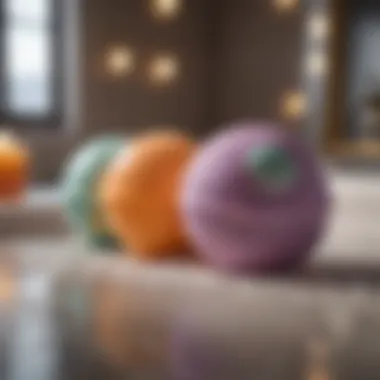
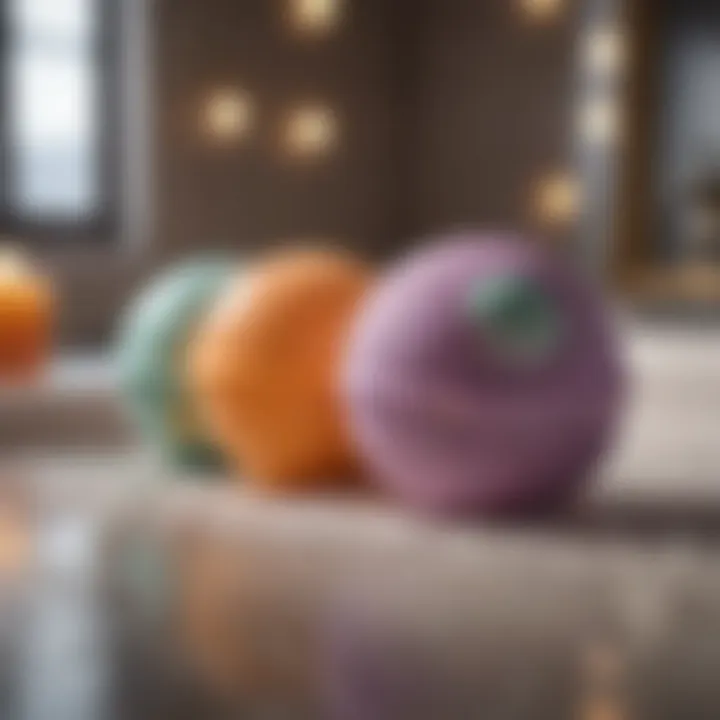
In this step, it is essential to mix the dry ingredients thoroughly. Combine the baking soda, citric acid, and Epsom salt in a large mixing bowl. A whisk or a spoon can be used to integrate these ingredients evenly. Ensuring that no clumps remain helps facilitate a uniform reaction when the ingredients are combined with wet elements later. The texture should feel fine and powdery before adding any liquid.
This phase sets the foundation for effective fizzing, so consistency is crucial.
Incorporating Wet Ingredients
Adding wet ingredients into the mixture is a delicate process. Combine essential oils and water in a separate bowl. It may be beneficial to use a spray bottle for even distribution. Gradually introduce the wet mixture to the dry ingredients. Stir continuously to prevent premature fizzing. It is important to add the liquid slowly to maintain control over the texture. The goal is to achieve a damp consistency that holds when squeezed together. Too much moisture will activate the fizzing reaction too soon.
Shaping and Molding
The next step involves shaping the mixture into your desired format. Use any molds available, whether they are special bath bomb molds or simple silicone molds. Fill each mold firmly, pressing down to ensure they compact adequately. This compacting is critical as it determines how well the bath bomb holds together once released.
Let creativity guide your mold choices. Smaller molds may create fun shapes, while larger ones could fit in a larger bath space. Consider a combination of shapes for added visual appeal.
Drying and Curing
After molding your bath bombs, it's vital to allow them to dry and cure properly. Place the bath bombs in a cool, dry place and let them sit for at least 24 hours. This drying phase allows the bath bombs to harden effectively. Uneven drying can lead to crumble or weakness, so it’s essential to check them after a few hours.
Once they are firm enough, they can be stored in an airtight container until use. Proper curing enhances the fizzing ability and overall quality of the bath bomb, ensuring a delightful experience during bathing.
Customizing Your Bath Bombs
Customizing your bath bombs adds a personal touch that enhances the bathing experience. This section explores how to make your bath bombs uniquely yours. Each component plays a critical role in the overall sensory experience, specifically through scent, texture, and visual appeal. Personalization empowers you to craft bath bombs that suit your preferences, making the act of bathing feel more indulgent and tailored.
Exploring Different Scents
Choosing the right scents can significantly elevate the bath experience. Essential oils are a primary choice for this purpose. Lavender, for example, is known for its calming properties, while citrus scents like lemon or orange can energize and uplift. Some other popular choices include eucalyptus for its refreshing quality and peppermint for a revitalizing effect.
When experimenting with scents, consider the desired outcome. For relaxation, a blend of chamomile and vanilla might be ideal. You can also combine different essential oils to create a signature scent. Here are some points to keep in mind:
- Potency: Start with a few drops; you can always add more.
- Compatibility: Some scents blend well, while others may clash.
- Quality: Select high-quality oils, as they impact both aroma and health benefits.
Incorporating Natural Additives
Natural additives enhance bath bombs not just in scent but also in skin benefits. Ingredients like dried flowers, oatmeal, or herbal infusions can be added. Dried rose petals or calendula bloom provide aesthetic appeal and may calm skin irritation. Oatmeal, on the other hand, is beneficial for its soothing properties, making it ideal for sensitive skin.
When considering additives, transparency is paramount. Some individuals may have allergies or sensitivities. It is essential to do a patch test with any new ingredients. Additionally, incorporating clays such as bentonite or kaolin can yield therapeutic benefits, supporting skin detoxification. Benefits of natural additives include:
- Skin nourishment: Many natural ingredients provide vitamins and minerals.
- Aroma enhancement: They can bolster or complement essential oil scents.
- Aesthetic value: Unique colors and textures can transform the visual appeal of the bath bomb.
Choosing Unique Shapes and Colors
Shape and color can significantly influence the emotional aspect of the bath. While traditional round shapes are popular, consider molds that yield stars, hearts, or any personal symbol. Unique shapes can be conversation starters and gifts, offering a creative outlet in addition to a practical product.
Color adds another layer. Using natural colorants like beetroot powder or turmeric not only dyes the bath bomb but also provides skin benefits. Alternatively, cosmetic-grade colorants can achieve vibrant and varied hues. When selecting colors, think about how they contribute to the mood and environment of your bath. Here’s a brief overview:
- Emotional impact: Certain colors promote relaxation, while others evoke energy.
- Visual contrast: Combining colors can yield interesting and striking designs.
- Mixing textures: Variations in shape and color create unique tactile experiences in bathing.
By thoroughly considering these aspects, any bath bomb maker can create functional art that serves not just as a bath addition but as a personal expression.
Benefits of Using Bath Bombs
Bath bombs have gained immense popularity in recent years, appreciated for their visually appealing nature and aromatic experience. They are not just a fancy addition to your bath; they offer tangible benefits that enhance both physical and mental well-being. Understanding these benefits is crucial for maximizing your bath experience. This section will delve into the two primary benefits of using bath bombs: relaxation and stress relief, along with skin benefits.
Relaxation and Stress Relief
The act of bathing has long been recognized as an effective way to unwind. Adding bath bombs to the equation elevates this experience. With their bubbly fizz and soothing aromas, bath bombs create a tranquil atmosphere. Many ingredients used in bath bombs, such as essential oils, are known for their calming properties. Lavender, for example, has been widely studied for its potential to reduce anxiety and improve sleep quality.
When you immerse yourself in a bath filled with a fragrant bath bomb, your senses are engaged, helping to divert your attention from daily stressors. The warm water combined with the therapeutic scents encourages muscle relaxation, alleviating tension accumulated throughout the day. This escapism can significantly improve mental clarity and promote relaxation, making it easier to cope with challenges.
"Taking time for self-care, like enjoying a bath with bath bombs, significantly boosts mental health and overall well-being."
Skin Benefits
Beyond soothing the mind, bath bombs can also contribute positively to skin health. Many bath bombs include nourishing ingredients such as Epsom salt, oils, and vitamins. Epsom salt is known for its ability to draw out toxins and soothe sore muscles, which can aid individuals after rigorous physical activity.
Furthermore, oils like coconut or jojoba promote skin hydration. As you soak in a bath bomb-infused bath, these oils act as emollients, aiding in skin moisture retention. This can be particularly beneficial for individuals with dry or sensitive skin.
Potential enhancements can include:
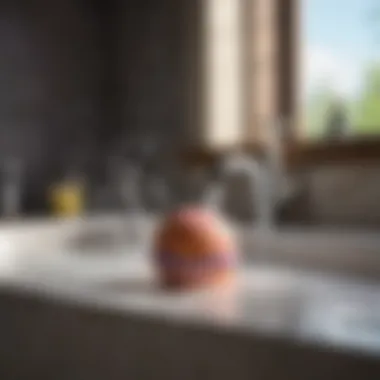
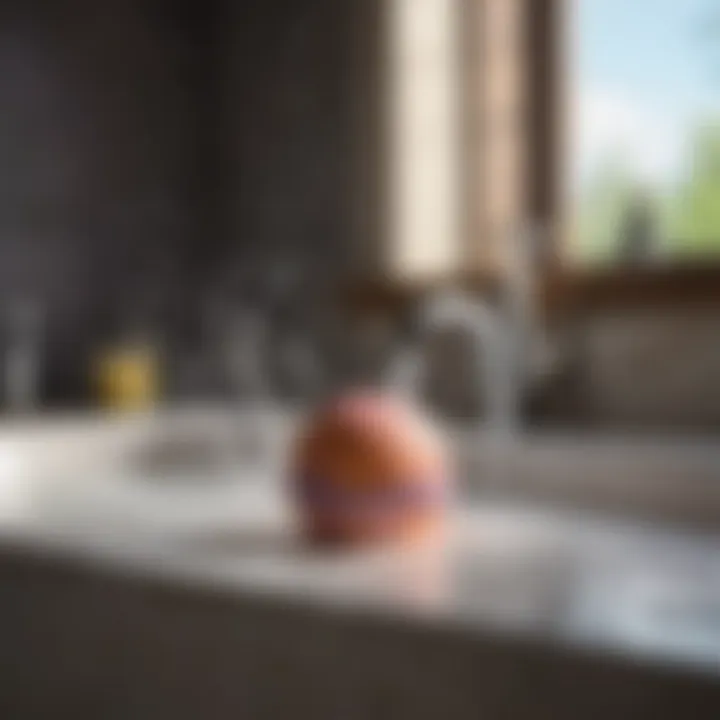
- Exfoliation: Some bath bombs are formulated with gentle exfoliating agents, which can help in removing dead skin cells.
- Soothing Irritation: Ingredients like colloidal oatmeal can alleviate skin irritation and provide relief from conditions like eczema.
In summary, the benefits of using bath bombs extend beyond simple indulgence. They play a pivotal role in promoting relaxation and contributing to skin health. By incorporating them into your self-care routine, you are investing in both your physical and mental well-being.
Common Issues and Troubleshooting
When crafting homemade bath bombs, some commonly encountered issues can affect your final product. Addressing these problems is essential to achieving the perfect bath bomb. Understanding why these issues occur will enhance your crafting experience and lead to better outcomes. This section will explore three common problems, providing insights into their causes and solutions.
Bath Bombs Not Fizzing
When bath bombs do not fizz as expected, it can be frustrating. This issue often stems from either incorrect measurements or improper storage of ingredients. Baking soda and citric acid are the primary agents that create the fizzing reaction. If the amounts are not balanced correctly, the fizz may be reduced significantly or entirely absent.
Moreover, if the dry ingredients have absorbed moisture before crafting, this reaction will diminish. Ensure that the dry components are stored in a cool, dry place. When mixing, work swiftly yet carefully, as prolonged exposure to humidity can lead to premature activation. Avoid using any container or surfaces that might retain moisture. In addition, inspect your ingredients for expiration dates, as age can affect chemical reactivity.
Crumbly Texture
A crumbly texture in bath bombs can result from various factors. One common reason is the lack of binding moisture. If the mixture is too dry, adding a little bit of water or oil can help unify the components. However, exercise caution—too much moisture will activate the fizz prematurely, ruining the batch before it is molded.
Another aspect to consider is the mixing technique. Inadequate mixing can lead to uneven distribution of ingredients. It is crucial to blend the dry components thoroughly before introducing wet elements. If a crumbly texture persists, reassessing the recipe and adjusting ingredient ratios may be necessary. Sometimes, a different type of oil or a slight addition of glycerin can enhance the consistency of your bath bombs.
Uneven Color Distribution
Achieving consistent color in homemade bath bombs can be challenging. Often, this issue arises from the manner in which colorants are added. To avoid uneven coloring, it is advisable to mix the colorants thoroughly into the dry ingredients before combining them with wet ingredients. This ensures a uniform disbursement throughout the entire mixture.
Colorants should be added gradually; a little goes a long way. Too much dye can not only alter the color but may also affect the texture. Mixing smaller batches can also lead to better control over color. If you notice uneven patches after molding, using an appropriate mold size can help create a more consistent appearance. Having a clear plan for color application will lead to more visually appealing results.
Remember: Attention to detail is key when getting the desired results for your bath bombs. Keeping a close eye on measurements and mixing techniques will significantly minimize common issues.
Storage and Usage Tips
Proper storage and optimal usage of homemade bath bombs are critical topics often overlooked. Understanding these elements enhances not just the longevity of the bath bombs but also guarantees a superior bathing experience. When bath bombs are stored adequately, their quality remains intact, ensuring that they deliver the intended fizz and invigorating scents. Likewise, knowing how to use them effectively can maximize their benefits, making the bathing ritual both luxurious and beneficial.
Proper Storage Methods
Storing bath bombs correctly plays an essential role in maintaining their structure and effectiveness. Here are key considerations:
- Keep them dry: Bath bombs absorb moisture. Store them in a dry location, away from humidity and direct sunlight. A bathroom drawer or a cupboard away from the shower is ideal.
- Use airtight containers: Consider using glass jars or plastic containers that close tightly. This will prevent moisture from getting in while also reducing the risk of them breaking.
- Avoid mixing scents: If you have different bath bombs with various scents, store them separately. Mixing them in a single container can lead to scent mingling, diminishing their unique fragrances.
- Label containers: If you make various batches, label each container. This is especially helpful if you have different types of essential oils or colors, allowing you to choose based on your mood easily.
By following these guidelines, you contribute to the longevity and quality of your homemade bath bombs, ensuring that each use is enjoyable and effective.
Optimal Usage Guidelines
Using bath bombs for the best experience involves some straightforward tips that ensure maximum benefits:
- Timing of use: The best time to use bath bombs is during your relaxation routine, ideally in the evening. This allows you to unwind and benefit from the calming effects of the essential oils.
- Water temperature: For best results, use warm, not hot, water. Hot water can dry the skin, whereas warm water helps open pores for better absorption of any skin-benefiting ingredients.
- Additives: If you like, you can add other elements to your bath. Milk powders or oatmeal can enhance skin nourishment, but ensure they mix well with the bath bomb for a balanced bath.
- Dosage: One bath bomb per bath is usually ideal. This allows for optimal fizz and fragrance without overwhelming the senses.
Consider these guidelines as a way to elevate your bath experience while enjoying the full benefits of your homemade creations.
"Properly storing and using bath bombs ensures they remain effective and enjoyable, maximizing both relaxation and skin benefits."
Adhering to these tips can make your bathing time refreshing and fulfilling.
Closure
The conclusion ties together the various topics discussed throughout this comprehensive guide on making bath bombs. It emphasizes the importance of both the process and the benefits associated with creating easy homemade bath bombs.
The key elements highlighted in the guide focus not just on the practicalities of crafting bath bombs, but also on their therapeutic effects. Bath bombs serve as a conduit for relaxation and self-care, enriching the experience of taking a bath. Additionally, the different ingredients can cater to various skin types, offering tailored skin benefits. This aspect is essential for health professionals and wellness coaches who understand the significance of holistic approaches to well-being.
Considerations such as storage methods and troubleshooting common issues can greatly enhance the experience of creating bath bombs. By summarizing the core techniques and encouraging experimentation, readers can be inspired to personalize their bath bombs further. Thus, the conclusion reinforces the notion that making bath bombs can be both an artistic expression and a restorative practice.
Recap of Key Points
- Definition and Purpose: Bath bombs enhance the bathing experience. They add fragrance, color, and skin benefits.
- Essential Ingredients: Ingredients like baking soda, citric acid, and essential oils are crucial for the fizzing action and sensory experience.
- Necessary Equipment: Basic tools include mixing bowls, molds, and measuring tools, which simplify the crafting process.
- Step-by-Step Guide: Preparing and mixing ingredients requires precision yet allows creativity in shaping and customizing.
- Customization Options: Different scents, natural additives, and shapes cater to individual preferences and needs.
- Benefits: Regular use offers relaxation, stress relief, and potential skin care advantages.
- Troubleshooting Tips: Understanding issues like fizzing problems or color distribution offers guidance for successful outcomes.
- Storage Tips: Proper storage ensures bath bombs maintain effectiveness and quality.
- Encouragement to Experiment: Readers should feel confident to modify recipes for unique experiences.
Encouragement to Experiment
Creating homemade bath bombs is not a strict science. It offers ample room for personal interpretation and creativity. As outlined in the guide, experimenting with different scents, colors, and shapes can lead to unique formulations tailored to individual preferences and needs.
For instance, blending lavender oil with other floral oils may produce a soothing aroma ideal for evening baths. Experimentation can also include the addition of natural ingredients like dried flowers or herbs, which can enhance both beauty and efficacy.
Readers are encouraged to try new combinations, whether it's varying the proportions of baking soda to citric acid or introducing unconventional colorants. This innovative approach not only makes the process enjoyable but also contributes to a deeper understanding of how each component interacts.
"The discovery lies in the experimentation. Each bath bomb becomes a personal touch to self-care rituals."
In summary, the journey of making bath bombs is both practical and creative. Embrace the variations. Engage in the craft. The potential outcomes are as diverse as the individuals creating them.



